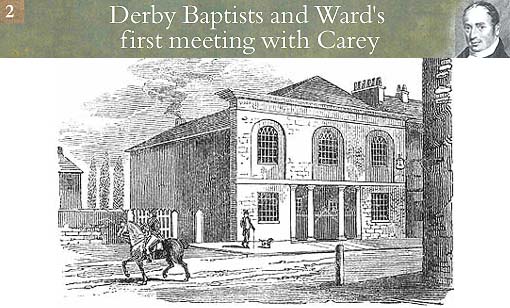

Agard Street Particular Baptist Chapel. Courtesy Derby Local Studies Library. The beginnings of the Baptist denomination in Derby According to Stennett, William 'was very early in life convinced of the truth and obligation of the baptism of believers by immersion' and 'was a warm and active supporter of the Baptist Church which was formed in Derby, about this time, in its first difficulties and depressions'. Stennett says William attended many meetings outside Derby. He 'often went over to Codnor, to Burton, and even to Nottingham (1), a distance of 18 miles, and was there before the resident members'. (2)
Ward did not 'make a public profession of his faith' until later, at Hull, in 1796.
I have not been able to find any records of the early years of the Particular Baptist cause in Derby, but since we know Ward visited Nottingham, it is possible that the cause was encouraged by the congregation at the Particular Baptist Chapel, Friar Lane, Nottingham. (3) The first Particular Baptist Chapel in Derby was opened on Agard Street on 12th June 1794, and was built 'at the sole expense of Archer Ward, esq. of Mill-hill house, in this town.' It had its own baptistry which was sometimes used by the General Baptists before they had their own chapel.
We do, however, have a more detailed history of the General Baptists in Derby. They trace the start of their denomination in Derby (4) to a sermon, preached in the open air, by Rev. Dan Taylor, at Willow Row, on 31st May, 1789. He was a General Baptist minister from London and had founded the New Connexion movement. He took as his text Luke 2:10 'Behold, I bring you good tidings of great joy'. (5) (6) (7)
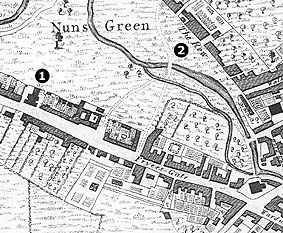
A 1791 map of Derby. 1. The Gaol. 2. Willow Row. Courtesy Derby Local Studies Library. After Dan Taylor's visit, preaching was continued by Nathaniel and Thomas Pickering of Castle Donington, in the same place, in the open air during fine weather. Soon after a room was hired for worship (8). It is believed that they met for a time in a private house near the gaol on Friar Gate. (8) Other churches within the Connexion supplied preachers and defrayed the expenses. (10) Nathaniel and Thomas Pickering came from Castle Donington, Leicestershire, Francis Smith and J. Smedley came from Melbourne, Derbyshire, and J. Goddard came from Ilkeston, Nottinghamshire. (11) A minister was appointed in 1800,
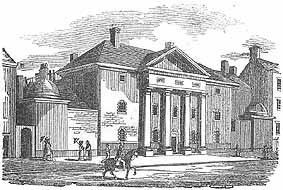
Derby Gaol, Friar Gate. Courtesy Derby Local Studies Library.
The first baptisms took place on 21st August, 1791. Gilbert Dallison, Joseph Burrows, John Etches, Joseph Johnson, Samuel Hill, Mary Porter, (12) Jane Porter, Rachel Etches and Margaret Pipes were to be baptised.
It is worth recounting a description of the baptism of John Etches. It comes from J. H. Wood's 'History of the General Baptists of the New Connexion' (p.194). William Ward may well have witnessed the scene himself and may also have known the people involved. The scene provides a vivid contrast with Marshman's later description of the first baptisms at Serampore.
'One of the nine was John Etches, a sailor, who lost his arm in the celebrated battle between Admiral Rodney and the Count de Grasse in 1782. After leaving the navy he returned to Derby, where he became notorious for the zeal and energy with which he engaged in the football contest which was annually held on Shrove Tuesday. One Lord's Day, when about to go to Normanton, one of his relatives said to him. "The Dippers are come to town, and preach in a room by the gaol". "The Dippers" he asked, "What are they?" "They call them General Baptists" it was replied, "They are of the same religion as our relatives in Nottingham." John went to the room. Francis Smith preached. Etches thought, as he quoted Scriptures so readily, he must be a gospel preacher, and resolved to go again. He attended until he found joy and peace in believing. He was for some time reluctant to submit to the ordinance of baptism. His hesitation was however subdued by our Lord's word's, 'Thus it becometh us to fulfil all righteousness.' The baptism took place on 21st August, 1791, in the River Derwent, near the Morledge. The Morledge was full of people. Thomas Pickering preached, standing on a stool in front of Etches' house. John was attired in his sailor's dress. Just as he was going into the water, a former football companion (13) called out from a neighbouring tree, "Jack, where's thy football now?" (14) But he had done with football forever. From that day he maintained an honourable Christian profession for 47 years. He became a deacon of the church 3 years after his baptism.' (15)
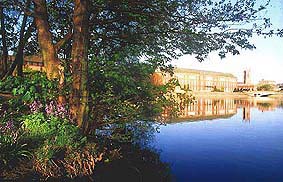
Derby, very close to the spot where the baptisms took place. The walk with Carey from Walnut Tree Alley to the Monument As editor of the 'Derby Mercury', Ward may well have travelled to London to deal with the newspaper publishers, booksellers, and manufacturers and wholesalers of medicines. They were the stock-in-trade of his employer's business. We know Ward developed an aptitude for business, even at so young an age.
These suppliers were based in the area around St Paul's Churchyard. It had become a prestigious and reputable address, just as Fleet Street became when the newspapers moved half a mile further west in the 19th century. The advertisements for medicines were an essential form of revenue. A typical supplier was James Newbury, who had a warehouse selling medicines such as Pectoral Essence of Coltsfoot and Dr. Steer's Opodeldoc. The address he gave was: 'St Paul's Churchyard, No 45, a few Doors from the Corner of Cheapside, towards Watling Street'.
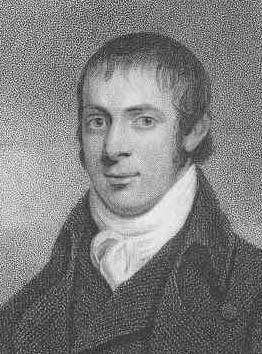
On 31st May, 1793, we know Ward was in London because he attended Rippon's Chapel at Walnut Tree Alley, Carter Lane, where William Carey was preaching. After the service Ward walked with Carey from Walnut Tree Alley (just a couple of hundred yards south-west of St Paul's Churchyard), to near the Monument (the Monument to the Great Fire of London). It is while they were walking that a conversation took place that would change both their lives.
S. Pearce Carey, in 'William Carey' describes it as follows: 'The week's most influential incident was being met on Sunday, the 31st, after preaching in Rippon's pulpit, Walnut Tree Alley, Carter Lane, by a Christian youth of twenty-three, named William Ward, a printer of Derby, who was visiting friends. They walked almost to the Monument together, and Carey unfolded to him the desire and purpose of his heart respecting biblical translations. Laying his hand on Ward's shoulder as they parted, he said, "I hope, by God's blessing, to have the Bible translated and ready for press in four or five years (an over-sanguine expectation; it took him seven). You must come and print it for us." Neither ever forgot this. Upon removal to Hull the next year, and baptism in the newly-formed 'George Street' church there, Ward was soon busy with village preachings. By 1797 he was in training for the ministry, and by 1800 was with Marshman alongside Carey in Serampore. The arrow reached its mark. Elijah's mantle rested on Elisha'.
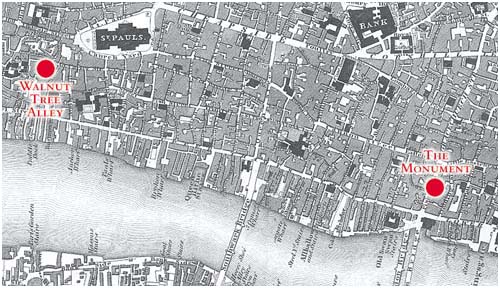
Just when Ward left Derby is not known. The editorials in the 'Derby Mercury' stopped in 1790. Carey describes Ward as 'a printer of Derby' in May, 1793. Ward's employer, John Drewry, died in 1794, and the paper passed to his son John Drewry II. (16)
The Town Hall, Stafford. Courtesy the William Salt Library, Stafford.
William Ward moved to Stafford (from where John Drewry's family originated), to start a newspaper, the 'Staffordshire Advertiser', (17) for John Drewry's brother, Joshua Drewry II.
Marshman tells us that Ward drew up a prospectus for the newspaper, which would have involved printing a dummy (just as Samuel Drewry had done, in 1730, for the 'Derby Mercury'), outlining his intentions, and the kind of stories he would be running. The first issue of the 'Staffordshire Advertiser' came out on Saturday, 3rd January, 1795. (18)
Very little is known about Ward's residence in Stafford. His new employer, Joshua Drewry II died in 1796 (19) and Joshua's wife died the same year at the age of 22. Stennett prints a poem (written by Ward, in Hull, in September 1796), in memory of Mrs Drewry. It is called 'To the Redbreast. A Sonnet' a reference to the fact that a red-breast alighted on the Communion Table during their marriage service. Ward had written poetry since his childhood.
(1) Possibly Friar Lane Baptist Chapel, where Carey later delivered his missionary sermon in May, 1792.
(2) No mention is made, in any sources I have found, to any contact between William Ward and the Moravian Settlement at Ockbrook. But, it is an astonishing fact, that within 5 miles of Derby there existed in Ward's time, an established Dissenting community founded on the same Moravian principles that were used as a basis for the community of brethren at Serampore. See 'The Moravian Settlement at Ockbrook' in the Miscellaneous section of this site.
(3) A further small clue to this premise is the fact that while his application to become a missionary was being considered at Kettering, and before he went to Birmingham Cannon Street, he visited Nottingham, from where he wrote a letter quoted by Stennett. The date of the letter is 8th November 1798. It is feasible that he was saying goodbye to his friends in Nottingham before leaving for India. In the letter he says goodbye to his friends in Hull. (See Chapter 4)
(4) It is tempting to read this as the beginning of the Baptist denomination in Derby. There are several reasons why this may not be the case.
a) In Simpson's 'History and Antiquities of Derby', 1826, Page 438, the author inserts a note in the section about the Particular Baptists which reads, 'Hutton speaking of his Grandmother, whose maiden name was Elinor Jennings, observes, "Her father was a Baptist Preacher one day in the week, and Shoe-maker the other six." He resided in St. Alkmund's Church Yard about 1660.' He is quoting from Hutton's Life, page 341.
b) Records of the early years of the General Baptist Church of the New Connexion exist in both the Derby Local Studies Library and the Derbyshire Record Office, Matlock. There are none in either archive for the Particular Baptists. The section quoted above comes from 'Records of the First General Baptist Church in Derby', S Taylor Hall, 1944.
c) The General Baptists were not in a position to open a chapel until 1802. The Particular Baptists had opened one in 1794. It is possible that the Particular Baptists had preached in Derby before 1789.
Until records for the early years of the Particular Baptists in Derby are found it is only safe to assume that this reference to the first sermon refers only to the denomination of the General Baptists of the New Connexion.
(5) The area around Friar Gate and Nun's Green was used for horse-fairs and cheese markets. Mountebanks set up their stalls near Vernon Street and attracted on-lookers with performing dogs, before selling their pills, potions and quack medicines. In 1745 the Highland Scots accompanying Bonnie Prince Charlie, on his way to take the English crown, had used Nun's Green to park their cannons while they were billeted in the town. The Town Gaol ,on Friar Gate, was where public executions took place (not dissimilar to Bow Bazaar, Calcutta). The basement cells of the gaol still exist, including the condemned cell.
(6) For a brief biography of Rev. Dan Taylor go to the Miscellaneous Page.
(7) For enlarged versions of the 1791 map and the 1806 map go to the Miscellaneous Page.
(8) 'Records of the First General Baptist Church in Derby', S Taylor Hall, 1944.
(9) 'Records of the First General Baptist Church in Derby', S Taylor Hall, 1944.
(10) The first minister was James Taylor, the nephew of Rev. Dan Taylor. 'Records of the First General Baptist Church in Derby', S Taylor Hall, 1944.
(11) 'Records of the First General Baptist Church in Derby', S Taylor Hall, 1944.
(12) Mary Porter married George Wilkins, who was baptised in April, 1792. He had been apprenticed to John Drewry, and had worked alongside his fellow apprentice William Ward on the 'Derby Mercury' ('Records of the First General Baptist Church in Derby', S Taylor Hall, 1944.)
(13) See Chapter 1, note 8, for a description of the Derby Shrovetide Football Match.
(14) The old Derbyshire dialect, heard in towns in the middle of the county such as Alfreton and Ilkeston, still uses 'thee', 'thy' and thou' in everyday speech. The original text says 'the' but in the context the speaker would have said 'thy', pronounced 'thi'.
(15) This extract from J. H Wood's 'History of the General Baptists of the New Connexion', is reproduced in 'Records of the First General Baptist Church in Derby', S Taylor Hall, 1944.
(16) 'Derbians of Distinction', by Maxwell Craven, 1998. Page 77.
(17) Marshman calls the newspaper the 'Stafford Mercury' but, according to the William Salt Library in Stafford there is no record of a 'Stafford Mercury' being published before 1863. Joshua Drewry did publish the 'Staffordshire Advertiser' and there is evidence that William Ward contributed poetry to it.
(18) Confirmed by the William Salt Library, Stafford.
(19) 'Derbians of Distinction', by Maxwell Craven, 1998. Page 77.